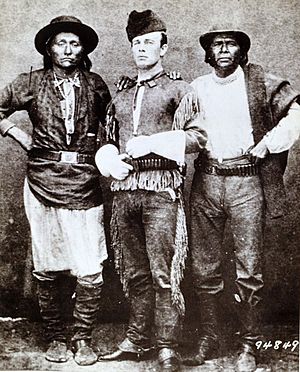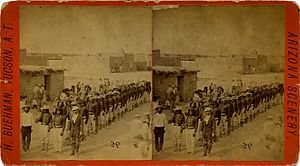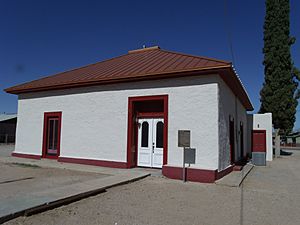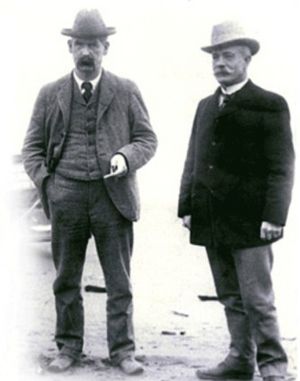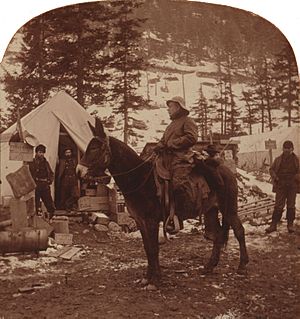John Clum facts for kids
Quick facts for kids
John Philip Clum
|
|
|---|---|
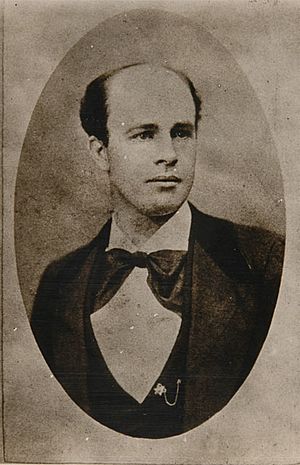
John P. Clum c. 1880
|
|
| Born | September 1, 1851 |
| Died | May 2, 1932 (aged 80) |
| Other names | Indian agent; first mayor of incorporated Tombstone, Arizona Territory; owner/editor, The Tombstone Epitaph |
| Known for | Only government agent to peacefully capture Geronimo |
| Spouse(s) | Mary "Mollie" (Ware) Clum Belle (Atwood) Clum Florence A. (Baker) Clum |
John Philip Clum (born September 1, 1851 – died May 2, 1932) was an important figure in the American Old West. He served as an Indian agent for the San Carlos Apache Indian Reservation in the Arizona Territory. He helped the Apache people set up their own government on the reservation. This idea was so successful that other reservations were closed, and their residents moved to San Carlos.
Clum later became the first mayor of Tombstone, Arizona, when it became an official town in 1881. He also started a newspaper called The Tombstone Epitaph on May 1, 1880, which is still published today. Later in his life, he worked in various postal service jobs across the United States.
Contents
John Clum's Early Life
John Clum was born on a farm in Claverack, New York. In 1867, he went to the Hudson River Institute, a military school. He also attended Rutgers College, where he studied many subjects like Latin, Greek, and Math. He even played on the Rutgers football team.
After college, Clum joined the US Army Signal Corps in 1871. He became a weather observer in Santa Fe, New Mexico.
John Clum was married three times. His first wife, Mary "Mollie" Ware, died in 1880 in Tombstone, Arizona. She passed away shortly after giving birth to their daughter, Bessie, who also died the following summer.
Becoming an Indian Agent
In 1872, President Ulysses S. Grant created the San Carlos Apache Indian Reservation. The government wanted religious groups to manage these reservations. The Dutch Reformed Church chose John Clum to run the San Carlos Reservation.
Clum knew that many Indian Agents before him had not done a good job. Some agents even stole money meant for the Apache people. The job was also difficult because military leaders and civilian agents often argued over who was in charge. The Apache people suffered because they did not always receive the food and housing they were promised.
Despite these challenges, Clum accepted the job as Indian Agent for the San Carlos Apache Indian Reservation on February 26, 1874. He arrived at the reservation on August 4, 1874. He found a place with a lot of violence and tension between the military and the Apache people.
Helping Apache Self-Government
Clum believed in treating the Apache people as friends. He started the first Indian Tribal Police and a Tribal Court. This allowed the Apache people to govern themselves. The Apache nicknamed him "Nantan Betunnikiyeh," which means "Boss With The High Forehead," because he was bald. Clum encouraged them to farm and raise cattle peacefully.
The Army did not like Clum's ideas because it meant they had less control over the reservation's money. Clum became frustrated with the Army's constant interference and the lack of support from the Indian Bureau.
Moving the Chiricahua Tribe
In 1872, the Chiricahua Apache leader Cochise had negotiated a special reservation for his people. However, after Cochise died in 1874, the government decided to close this reservation.
In May 1876, the government ordered Clum to move the Chiricahua people to the San Carlos Reservation. Clum began relocating the tribe in early June. Some Chiricahua leaders, like Cochise's sons Taza and Naiche, agreed to the move. However, many others tried to escape to Mexico. Only a small number of Chiricahuas moved with Clum to San Carlos.
In April 1877, Clum was also ordered to move other Apache bands from the Ojo Caliente Reservation in New Mexico to San Carlos.
Capturing Geronimo
One famous Apache leader, Geronimo, did not want to move. On April 21, 1877, Clum used a clever plan. He hid 100 of his Apache police in a building at Ojo Caliente. They surprised Geronimo, took his rifle, and put him in chains. This was the only time Geronimo was captured without a fight.
A total of 453 Chiricahua Apaches, including Geronimo's group and others led by Victorio, arrived at San Carlos in late May. However, they often argued with the other Apache groups already living there.
Clum Leaves His Post
Clum's disagreements with the military grew worse. He felt frustrated by officers who disagreed with his methods and by the lack of support from the Indian Bureau. He left his job as Indian Agent on July 1, 1877.
After Clum left, his replacement freed Geronimo and his men. This led to many years of conflict until Geronimo was finally captured again in 1886. Clum always believed that his work with the Apache people was the most important thing he ever did.
Life in Tombstone
After leaving his job as Indian Agent, Clum moved to Florence, Arizona. He bought a newspaper called the Arizona Citizen. He used the newspaper to criticize the Army and politicians.
When silver was discovered in Tombstone in 1877, Clum moved there. On May 1, 1880, he started his own newspaper, The Tombstone Epitaph. He also helped create a "Vigilance Committee" to stop crime in Tombstone. His work with this group helped him get elected as Tombstone's first mayor in 1881.
While mayor, he became good friends with Wyatt Earp and supported him strongly. In December 1880, Clum's first wife, Mary, died in Tombstone.
Clum and his newspaper supported the lawmen in Tombstone. Because of this, he became a target for outlaws. In December 1881, a stagecoach he was riding in was attacked. Clum believed the attack was an attempt to kill him. He managed to escape and returned to Tombstone.
After a famous gunfight in Tombstone in October 1881, Clum, along with Wyatt Earp and others, received threats. In January 1882, Wyatt Earp's brother, Virgil, was injured in an attack, and another brother, Morgan, was murdered in March.
On May 1, 1882, exactly two years after starting The Tombstone Epitaph, Clum sold the newspaper and left Tombstone. The newspaper is still published today, telling stories about the Old West.
Later Years and Passing
In 1898, John Clum was appointed Postal Inspector for the Alaska Territory. His job was to set up a postal service there. He traveled thousands of miles across Alaska, setting up new post offices.
In the summer of 1900, while in Nome, Alaska, Clum met his old friend Wyatt Earp. Clum later became the postmaster for Fairbanks, Alaska, a job he held until 1909. A town in Alaska, Caro, was even named after his daughter.
John Clum left Alaska in 1909. For several years, he traveled the country, giving lectures to encourage tourism and train travel. In 1928, he moved to Los Angeles, California, where he lived until he passed away in 1932 at the age of 80.


